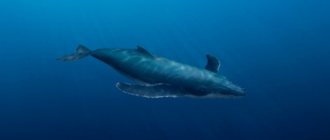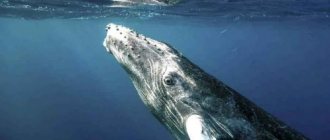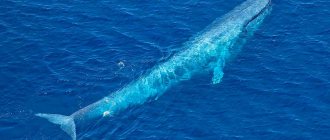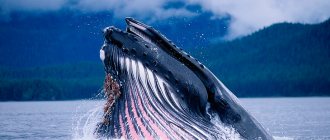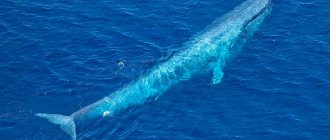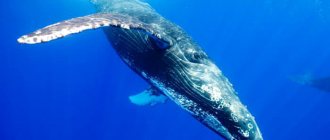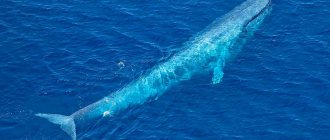About whales.
Since ancient times, in the mythology of various countries and peoples, there have been references to terrible monsters from the depths of the sea that eat people and send ships to the bottom. In the myths of Ancient Greece, these monsters are called “kitos” (“sea monster”). Actually, the modern name “whale” comes from this word.
Whales are the largest creatures on the globe. These are huge mammals that have chosen the waters of the World Ocean as their habitat.
Scientists distinguish three main orders of whales that lived and live on Earth today: baleen whales (or Mysticeti), toothed whales (Odontoceti), ancient whales (Archaeoceti) - a long-extinct group. All three of these orders include about 130 living and 40 extinct species.
Appearance, dimensions, body structure.
All cetaceans have impressive sizes, but depending on the species, the body of a whale can reach a length from 2 to 25 m. The largest are blue whales, and the smallest are white-bellied dolphins.
Cetaceans have perfectly adapted to life in the aquatic environment. Despite the fact that they resemble fish in appearance, the structure and characteristics of the body of these two classes are very different. Whales are warm-blooded animals. Their body usually has a teardrop or torpedo shape. The streamlined body is covered with thin hairs that do no harm, but also no benefit. The body ends with two powerful flat fins. And although they do not have a bone base, they consist of very dense cartilage. Thus, the tail performs the main function of moving the animal forward.
Pectoral fins are modified limbs of land mammals. When the whale moves, they act as a rudder, a direction regulator. The whale's body has no glands other than mammary glands.
Thanks to their streamlined bodies, whales are able to overcome water resistance. This is also facilitated by the lack of hair and ears. In addition, the survival of whales in cold currents is helped by a thick layer of fat, which protects the animal from hypothermia.
Habitat and lifestyle.
Whales are distributed everywhere, in all oceans and in almost all seas. Many species choose polar arctic waters, some can be found in warm tropical and subtropical latitudes.
Most whales are gregarious individuals. Animals live in groups ranging from ten to several hundred, or even thousands of individuals.
Whales also differ in their gastronomic preferences - most of them feed on plankton or small fish. The most predatory species of whale, the killer whale (although the correct name is killer whale), eats even small land animals.
Many whales migrate annually in currents in search of a new habitat with an abundance of food. Some, mostly small species, can even move in rivers.
Reproduction and feeding of babies.
For the most part, whales are monogamous creatures. Although males have the ability to fertilize all year round, most species produce offspring once every 1.5-2 years. The duration of pregnancy (depending on the type) ranges from 7 months to one and a half years. The cubs are born directly under water, and are already quite developed and capable of movement.
The baby consumes mother's milk often and in small portions. Within a few seconds, the female squirts milk into the baby's mouth. On average, a female can produce up to 1 liter of milk per day, which is quite enough for the full development of the baby. Since whale milk has a very high fat content, babies grow by leaps and bounds.
At the age of approximately 5 years, the whale reaches sexual maturity, but the process of growth and development of the body stops only after 10-12 years of life. The average lifespan of cetaceans ranges from 30 years (for small species) to 50 years for giants.
Today, many species of whales are listed as endangered, and hunting them is prohibited in many countries by an international moratorium.
Description and characteristics of whales
Whales are distinguished by their gigantic body sizes. Of course, length and weight vary from species to species. For example:
- Blue whale - body length 33 meters, weight 150 tons
- Dwarf whale - 5-6 m, weight approximately three and a half tons.
They are warm-blooded animals. Their body temperature is constant (about 35 to 40 degrees). The presence of a large layer of fat in whales saves them from hypothermia.
Whales breathe using lungs that have elastic muscles. Thanks to this, they have an air exchange of approximately 90% during inhalation and exhalation (if compared with a person, it is only 15 percent). Due to this, whales calmly dive into the water for 20-40 minutes, and a sperm whale, after taking a breath of air, can remain at a depth of about an hour and a half. Therefore, when whales rise to the water surface, the air they exhale condenses. This promotes the formation of a fountain. Large species of animals release a fountain under strong pressure, emitting a loud roar. It spreads over a distance of several kilometers.
Southern minke whale
Scientific name: Balaenoptera bonaerensis Average length: 7.2 - 10.7 m. Weight: 5.8 - 9.1 tons
The Antarctic or southern minke whale is one of the smallest known species of baleen whale. The longest specimen ever recorded was 11.9 meters long.
Due to their relatively low weight (amount of meat), this species was ignored by whalers. However, minke whales are endangered.
Although Antarctic minke whales are found exclusively in the southern hemisphere, numerous sightings of them have been reported north of the equator.
We have shared with you information about some species of cetaceans. The editors of TopCafe hope that this information was useful to you. We will be happy to read your comments on the article. Write what other species of whales you know, perhaps you have met them in the wild.
Types of whales
Humpback whale (minke whale)
The whale was so named because of the convex fin on its back, which looks like a hump. The body of humpback whales can have a length of 14.5 to 18 meters, and they weigh on average 30 tons. Distinctive features of humpback whales:
- Short body;
- Various colors;
- At the top of the head there are warty protrusions.
Humpback whales live in almost all parts of the world's oceans. They are not found only in Antarctica, and also in the Arctic. They eat fish and crustaceans.
Singing humpback whales
California or gray whale
The body length of gray whales can be from 13 to 15 meters, and their weight ranges from 14 to 35 tons. Females are longer than males. The color of the body is brown-gray or dark brown. These whales are the only ones that forage for food on the ocean floor. They have a keel-like projection under the lower part of their jaw. Gray whales pry through the mud and pull out worms, mollusks and other living creatures from underneath it. Habitat: northern seas; in winter they migrate to the south of Japan. These whales can cover more than 12,000 kilometers during their migration period.
Greenland or polar whale
This unique baleen whale is attracted to the very cold waters of the northern part. Polar whales live more than 40 years. The body of males can be about 18 meters long, and that of females up to 22 meters. The fountains at the whales are 6 meters high. Adult bowhead whales weigh about 150 tons and can eat about two tons of food daily. Whale skin is gray or dark blue.
Sperm whale
Sperm whales have a gigantic head, and from the side their muzzles look like an oblique rectangle. Male whales reach a length of 20 meters and weigh almost 50 tons. The sperm whale's mouth contains cone-shaped teeth. Each tooth weighs almost a kilogram. The color of the sperm whale's skin is dark gray with blue. She is covered with wrinkles. The sperm whale is a predator. It feeds on large fish, squid, cuttlefish, and sometimes swallows sharks. Sperm whales have the ability to dive to great depths and stay in the water for quite a long time. Sperm whales inhabit the entire World Ocean, but prefer a tropical climate. The sperm whale's mouth is very large. There were cases when they swallowed human whalers.
Blue or blue whale
This whale is the largest whale in the world and also the largest animal on planet Earth. The whale weighs about 150 tons, and its body length is 33 meters. Its body has an elongated shape, and its muzzle is quite narrow. The color of the body is gray-blue with spots over the entire surface of the body. Whale skin resembles marble. The blue whale's main food is plankton.
Fin whale
A distinctive feature of fin whales is the asymmetrical coloration in the muzzle area. On the left, the jaw in the lower part is dark in color, and on the right, it is white. Fin whales weigh from 40 to 70 tons. The slender body has a length of 25-27 meters. They feed on crustaceans. They spend the winter in the warm temperate zone, and when it gets warm, they migrate to Antarctica and the Arctic.
Dwarf or right whale
The size of the whale is relatively small. Adult whales are only 4-6 meters long and weigh around three and a half tons. The skin of the dwarf whale is gray with dark spots, but there are also black whales. They move in waves and eat plankton. This is a very rare species, found only in the waters of New Zealand and Australia.
Belukha
The animal was named so based on its body coloring. The weight of the beluga whale is relatively small; it can be within two tons, and its body length is about six meters. It is interesting that beluga whale calves are dark blue at birth, then it becomes light gray, and in adults it becomes white. The beluga whale has a small head and a rather high forehead. She has no fin on her back, and the fins on her chest are shaped like ovals. Beluga whales have very good hearing and echolocation abilities. The lifespan of beluga whales is approximately 40 years. Beluga whales primarily live in the Arctic, but also make seasonal migrations.
killer whale
A distinctive feature of the killer whale is its high dorsal fin, which is more than one meter high. The killer whale's body is ten meters long and weighs about 8 tons. Killer whales are fast and active predators. They can reach speeds of up to 55 km/h. Killer whales feed on porpoises, sea lions, seals, and walruses. Killer whales have strong bonds with their calves and with each other and mostly live in herds.
Spotted wobbegong
The spotted wobbegong, also called the carpet shark, is one of 12 species of sharks in the wobbegong family. The fish got its name due to its wide and flat body with a color adapted for camouflage on the seabed. These sharks differ from other representatives of the order in their special color, with an iridescence from golden sand to light green with white rings. They also have 6-10 skin lobes on both sides of the head and nasal projections used for navigating space.
Carpet sharks are endemic to the southern coast of Australia, living in the seagrass of rocky reefs, as well as on sand and coral reefs at depths of up to 110 meters. Sometimes they can be seen in shallow water, where the water barely covers the bodies of wobbegongs. Sharks spend most of the day lying down on the bottom. They become active only at night, slowly swimming towards the victim. Carpet sharks feed on bottom-dwelling fish and invertebrates, including lobsters and octopuses. Often after a hunt, wobbegongs return to their original place for a daytime rest.
Despite their slowness and relatively small size, carpet sharks can be quite aggressive. There have been 4 recorded cases of unprovoked bites of humans by spotted wobbygongs, as well as 28 bites by unidentified sharks from this order. As a rule, having bitten the offender, sharks immediately release him.
Spotted wobbegongs are considered a desirable catch for anglers, which has led to a significant decline in their numbers. Between 1990 and 2000, their catches decreased by 60%. The tough, attractively patterned skin is used to create jewelry, and carpet shark meat is considered a delicacy.
5
General characteristics of whales
- Whales have a teardrop-shaped body. It allows you to experience the least resistance from the water while swimming.
- The animals' heads are massive and end in blunt and narrow beak-like structures. The nostrils are shifted to the crown area. Whales have no sense of smell.
- Whales do not have a neck; the head is smoothly connected to the body, which narrows when passing into the tail.
- In the chest region of whales there are flippers, with the help of which whales steer, turn and brake.
- The muscular and flexible tail, which has a flattened shape, works like a motor. The tail is equipped with blades located horizontally. Many species of whales have a dorsal fin, which acts as a stabilizer when moving through the water.
- In relation to the body, the size of the eyes is small: with a diameter of 10 to 17 centimeters. In large-sized species, the eye can weigh almost one kilogram. Whales have poor eyesight. Despite the fact that the body is equipped with conjunctival glands, they see poorly.
- Toothed whales have cone-shaped teeth. In toothless whale species, teeth are replaced by bony plates.
- The skeleton has a spongy structure, and the spinal discs are elastic. Due to this, the body of animals is maneuverable and flexible. The number of vertebrae can be 41-98.
- The skin of whales is mostly smooth, with single bristles in the muzzle area.
- The body has a uniform color, sometimes spotted or dark at the top and light at the bottom. There are species of whales that change body color as they age.
- Whales have very poor taste. They only taste the salt.
- Whales hear only low-frequency sounds, close to ultrasound, but they have an excellent sense of touch.
- Whales do not have vocal cords, but they do have an echolocation organ that allows them to make sounds. The concave bones of the skull play the role of a reflector that receives ultrasonic signals.
- Whales generally move slowly. But they can reach speeds from 20 to 40 kilometers per hour.
Giant grouper or guasa (2.5 m)
The giant grouper from the Serranidae family of marine fish can be found on the coasts of Brazil, in the Caribbean Sea. Fishermen call the giants, which grow up to two and a half meters, with the affectionate word “guasa”. The maximum recorded weight of the predatory fish is 363 kilograms. It was exterminated for many years because of its tasty, dense meat.
In recent years, fishing for grouper has been prohibited; the population is gradually recovering. Rock perch lives in coastal reefs and aggressively defends its territory. It is distinguished by its massive carcass and spiny gill covers. Eats turtles and fish.
Whale habitats
Whales live in all the oceans of the globe. They generally prefer a herd lifestyle. Animals unite in large groups. The quantitative composition ranges from several tens to a thousand or more animals in a group. But the largest whales can live alone.
There are species that migrate. This is due to changes in weather conditions. When winter comes, whales move to areas with warm waters. There they often give birth to cubs. When the summer season begins, they prefer to be in places with a temperate climate.
Whales swim close to the surface of the water because they need air to breathe. They dive to a depth of up to 500 meters.
Sperm whale
Scientific name: Physeter macrocephalus Length: 16 – 20 m. Weight: about 41 tons
The sperm whale is the largest living toothed whale.
Its diet consists mainly of stingrays, deep-sea fish and small sharks. About a third of the sperm whale's body consists only of its head. The name is also associated with this structural feature of the mammal’s body - in a number of Romance languages, the word “sperm whale” means “big head.”
Sperm whales, like gray whales, have the largest distribution range of any animal. Depending on biorhythms and some morphological features, southern and northern sperm whales are distinguished.
Interesting fact: sperm whales have the largest brains of any other animal. Their head makes up a third of the animal's entire body
16
What do whales eat
The main food of whales is plankton (small organisms that live in the upper layers of the water layer). Their diet is dominated by crustaceans of various species, which gather in large flocks.
Possessing a huge mouth, whales swallow large volumes of water at once. Shellfish, fish and other species are drawn in with the water.
The killer whale is a cetacean species. In addition to fish, it feeds on animals such as guinea pigs, seals, penguins, and dolphins. She can even eat another whale.
Classification
All whales are divided into two large groups, so-called suborders. Although it is worth noting that scientists distinguish three suborders. One of them is ancient whales. All representatives of this group have long since died out, and there is no particular point in describing them. We will talk about animals that still swim in the oceans and seas, although there is a threat of their extinction.
One of these suborders is baleen whales. In addition, they are often called “real whales.” The second suborder is toothed whales. Smaller representatives, which include dolphins and porpoises, but more on that later. I would like to note that different species of whales are being destroyed. In particular, this applies to those who have the greatest value in the fishery. This is a blue whale, fin whale, humpback whale, etc.
Whale breeding
Most whales are monogamous and calves are born once every two years. When whales are 4-5 years old, they already become capable of reproduction. But full physical maturation occurs only at 12 years of age. Mating continues for almost a whole year.
Female whales carry their calves for 7-18 months (the length of time depends on the species). Whales that do not migrate give birth in the summer. In other whale species, offspring are born in warm waters.
Female whales always give birth to one baby. She gives birth in the water column. It comes out with the tail part and its length is almost half the size of the female’s body. And its weight is approximately two to three tons.
Baby whales can immediately swim on their own, but still do not swim far from their mother. The female's maternal instinct always kicks in.
Whales feed their young in the water. Female milk has a fat content of about 54%; it does not even spread in water. Mothers feed their babies for about seven months, and sperm whales for thirteen months. After finishing feeding with mother's milk, the cubs increase in size by half their length. During the entire time the female is feeding the baby, the whale is constantly near its family and does not leave it.
Whaling
For many years, humans hunted for precious whale oil, used in the production of glycerin, margarine and soap making.
Decorative lipstick, cosmetics and all kinds of creams containing spermaceti, which is extracted from the head of sperm whales, are in particular demand.
It is surprising that for many years women's corsets and furniture springs were made from whalebone, and the secretion of the pancreas was the basis for the production of insulin and other medications.
Due to uncontrolled whaling, many species of whales were completely exterminated.
Today, most cetaceans are listed in the Red Book, and commercial whale hunting is prohibited in all civilized countries.
The most interesting facts about whales
- The blue whale's tongue weighs four tons. It is so huge that if you imagine that people could stand on it, then about fifty people could fit on it
- When they die, whales explode. This happens because internal decomposition occurs and gases are formed that produce toxins. Dead whales often wash ashore. The internal pressure is much greater than atmospheric pressure, resulting in an explosion.
- Whales can go without sleep for one hundred days and without food for about ten months.
- You can't even find two whales with the same tails. Each whale has its own unique tail, just as each person has its own unique fingerprint.
- When whales dive to great depths, rather fat tears begin to roll out of their eyes. They are designed to protect your eyes from salt and help them see better.
- A substance called spermaceti is extracted from the head of sperm whales. It is added to cosmetics: cream and lipstick.
- The blue whale has the largest heart in the animal kingdom. Its weight ranges from 650 to 700 kilograms. The diameter of its vessels is approximately equal to the diameter of a ten-liter bucket. About 8,000 liters of blood circulate through the vessels every day.
- Ambergris is extracted from the intestines of sperm whales and is used in the perfume industry as a flavor stabilizer.
- Of all whale species, bowhead whales have the longest life expectancy. They live for about two hundred years. A whale of this species has been recorded to live for 211 years.
- When a whale dives to a greater depth of approximately 3.5 kilometers, a slowdown in the rhythm of its internal organs is observed. The heart makes only ten beats per minute.
The savannah elephant is the largest animal on land.
Most likely you are wondering how much does an African elephant weigh? The African elephant (Loxodonta africana) is considered the largest land animal on the planet. It is also called the Savannah Elephant and it is many times smaller than the blue whale, but larger than other representatives of the animal world.
The height of the African elephant reaches 4 meters and length – 7 m. The weight of the African elephant is about 10 tons. The largest elephant and the largest animal in the world is a male elephant weighing over 12 tons. The elephant was shot in Angola and entered into the Guinness Book of Records.
Proboscis mammals appeared on the planet 2 million years ago; at the moment there are three species of elephants - Savannah, Forest and Indian elephants. Elephants are the only representatives of animals that have an appendage - a trunk, a kind of extension of the lip. With the help of their trunk, they can drink, eat, lift heavy objects and even care for their young. If an African elephant weighs about 10 tons, then the weight of its trunk can fluctuate around 120-140 kg, but it is flexible enough and allows the elephant to perform various manipulations with it.
The savannah elephant is the largest animal on land.
They also have incisors that have transformed into tusks. It is not for nothing that elephants are given huge ears by nature - this is how animals fan themselves with them and cool their bodies. The length of each such ear can reach 1.5 meters in height. An elephant has an exceptional pattern on its ears, formed by blood vessels, each one has its own pattern, much like a person has fingerprints. The elephant's skin is rough, dark gray in color, there is a tassel on the tail - this is the remnant of the hairline (the baby is completely covered with hairs). Despite the toughness of the skin, it is susceptible to attack by insects and heat. To protect themselves, representatives of proboscis douse themselves with water and bathe in dust.
The African elephant's habitat has shrunk from 30 million square meters before. km, now it’s only 5.3. The population of large elephants is concentrated mainly in Mali and some other African countries, but there the animals are protected by national parks.
Life of an African Elephant
Elephants are socially organized land animals. They stay in groups of about 10 elephants in a herd. Their instincts are clearly manifested, especially at the time of mating or courtship of offspring. At these moments, the elephant can show aggression, and if a person gets in its way, it can even trample. During the remaining periods of its life, the elephant is absolutely harmless. The elephant is distinguished by its endurance; in search of food it can travel up to 500 km without feeling discomfort.
Top Articles : Deforestation: Definition, Rate, Control and Harm
Elephants spend most of their time searching for food and absorbing food, and only about 40 minutes resting, which they prefer in the heat of the day. Interestingly, adult elephants sleep standing up, gathered in a group, and a baby can fall on its side and thus rest.
Elephants always protect their offspring from attacks by leopards, hyenas and crocodiles. The female elephant also rules the herd and drives the males out of the herd after maturity. And they, in turn, stay alone or create their own groups consisting of males.
African elephant calves.
Communication between African animals occurs through sound that can be heard at a distance of 10 km
Elephants see poorly, but sense danger well, or vice versa, attention and affection. They can greet each other and “hug” for about 10 minutes, touching their trunks, or rubbing against each other
The elephant is an intelligent animal that can easily be included in the top ten most intelligent animals in the world. The lords of the savannas live for about 60-70 years, dying mainly from old age, when they can no longer chew food and starve. But besides this, elephants face other problems:
- Diseases – arthritis, tuberculosis;
- Disappearance of vegetation in elephant habitats, desertification of lands;
- Extermination of elephants for ivory;
- The military situation in African countries and the development of territories by people are unstable.
